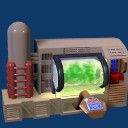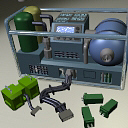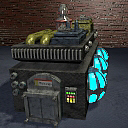|
|
 Power Systems
Power Systems
This general power systems page deals primarily with the systems which
would be used to provide power to society on a day-to-day basis.
Starship
and vehicle power, while often generated by similar means, are dealt
with in their own respective sections.
| Antimatter reactor |
| Antimatter is released to react with matter. Big
energy results in the form of high-energy gamma rays which are
harvested into heat and electricity. Antiparticles may be
delivered to the generating station or
produced by an on-site antimatter production facility. They are stored in a
containment unit. They vary
in size from factory sized units that power several cities to
smaller generator sized units. |
 |
|
| Compost system |
Enormous cities generate enormous amounts of trash.
Wise civilizations will generally have some sort of aggressive, highly
advanced waste reclamation system. In the case of a composter, all
the organic waste produced is gathered and exploited.
Engineered bacteriological agents are used to convert waste
products into reusable materials, electricity, heat, and
exploitable gasses.
Even fully advanced compost systems
are incapable of fuelling the entire city that produces them but they
are capable of significantly offsetting the necessary energy and
providing some very useful exploitable resources. |
| Fossil fuel |
More primitive civilizations rely on processing and
burning the liquefied or gaseous remains of dead creatures. A
dirty, filthy inefficient way to power things but sometimes
necessary until a civilization matures. |
| Fuel cell |
 |
The fuel cell is a highly
functional, high scalable source of energy. Basically, the
fuel cell combines hydrogen and oxygen and produces
electricity and either water or steam. The water can be
reclaimed and easily split back into hydrogen and oxygen by
hooking up the fuel cell to an external energy source, or can
be used, worst-case, to bring life to local flora. In systems
that produce steam, it can itself be harvested and used to
drive turbines as a secondary source of electricity. |
Because fuel cells generate primarily DC power
which does not travel distances well, they tend to be employed
locally. Depending on size, they make excellent power sources for
personal electronics, for vehicles, and as generators for homes,
factories, offices, and city blocks. The fuel cell works
constantly and is never "shut off". Most systems with
wide-spread fuel cell use have facilities to plug individual fuel
cells into the public power grid where they will deposit their
energy when not powering their primary devices.
|
| Fusion Reactor |
 |
Nuclei of atoms
are fused together in an endothermic reaction. The energy of
the fusion reaction is harvested by a Concipital Trajector
Field, which converts the heat and molecular kinetics from the
reaction into DC electricity.
The DC power is converted to AC
and transmitted through the local power grid. |
Fusion reactors are a relatively primitive source of energy
but still fairly common, even on advanced worlds. They remain
a safe, simple, and efficient source of power from plentiful
fuel sources. |
| Hydroelectric |
Naturally flowing water
in the form of a river or tides are used to turn propellers and
generate electricity. This is non-portable power that is generally
used to power cities. |
| Particle Furnace |
The particle furnace uses
rotated
particles as fuel, using quantum fields to control the release of energy from their
Blind dimension and harnessing the resulting dirty energy with a
Concipital Trajector Field to
create heat and electricity.
Rotated particles see fairly common use in handheld weapons but are
not suitable for similarly sized power sources. Large, delicate
quantum field generators are needed to control their reversion to
the Tangible state in a manner that is safe and controlled enough to
produce harnessable power. This and the need for storing large quantities of
potentially dangerous rotated particles limits their use to large
reactor-type installations suitable for powering starships and
cities. |
| Singularity generator |
"Small", artificially created black holes.
They spit off a number of interesting and useful particles,
including matter/antimatter pairs, as well as a certain amount of
heat. The smaller the singularity, the more energy it releases.
They need to be fed matter or they become unstable and explode in a a
burst of intense radiation. While they are tiny and provide a
large amount of energy for a long time, the equipment used
to contain the singularity and harvest its products is enormous.
This is another product suitable only for starships and cities. |
| Solar |
Passive energies
emitted by suns can be harvested with solar panels of varying
sizes. Solar films can be used to make or coat anything from
clothing to vehicle finish to roofing materials. Many common
articles of clothing are made of solar film and include microcells and power jacks for small personal electronics.
The limited power that solar energy can harvest leads to its use for
personal electronics and for supplementing the power supply to
cities and individual facilities. |
| Wind farms |
Wind is used drive
propellers and generate electricity. This is non-portable power that
is generally used to power cities. |
| Wireless Power |
Small, low power technology like
neuralinks and other communication equipment often run off
"wireless power", or "environmental power". Equipment is designed to include nano-generators,
which generate power by
harmonically resonating with common local broadcasts like radio or
microwaves. What is essentially background noise fuels the
majority of daily, low power devices. |
Distribution
Major power systems generally involve an enormous centralized
generating station of one sort or another, whose energy is
distributed in the form of AC electricity through a copper wire
network for use elsewhere. At the point of use, the AC power
is reduced to safe voltage levels by transformers. Individual
electronics then often convert the AC electricity to DC
electricity, or use the AC electricity to charge batteries which
are used to power devices.
|
|
|